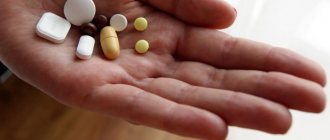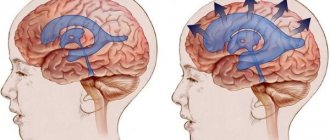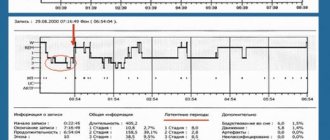In May 2021, the US Food and Drug Administration (FDA) approved Aimovig (international nonproprietary name: erenumab), the first fully human antibody for the treatment of migraine. This medicine, developed jointly by the pharmaceutical companies Novartis and Amgen, has a fundamentally different mechanism of action than the drugs traditionally used to treat migraine. Will Aimovig be able to significantly reduce symptoms and improve the quality of life of migraine sufferers? Let's try to figure it out.
pharmachologic effect
Serotonin 5-HT1 receptor agonist. A drug with antimigraine activity.
Pharmacokinetics
After oral administration, it is quickly absorbed. 70% of the maximum plasma concentration is achieved after 45 minutes. Cmax in blood plasma is 54 ng/ml. Bioavailability - 14% (due to first-pass metabolism and incomplete absorption). Plasma protein binding is 14-21%.
Metabolized by oxidation with the participation of monoaminoxylase (mainly isoenzyme A) with the formation of metabolites, the main of which are the indoleacetic analogue of sumatriptan, which does not have pharmacological activity against 5-HT1-serotonin receptors, and its glucuronide. It is excreted by the kidneys, mainly in the form of metabolites.
Pharmacodynamics
Sumatriptan is a specific selective agonist of 5-HT1-serotonin receptors, localized primarily in the blood vessels of the brain and their stimulation leads to a narrowing of these vessels. Does not affect other subtypes of 5-HT-serotonin receptors (5-HT2-7). Activates the sensitivity of trigeminal nerve receptors. The therapeutic effect usually occurs 30 minutes after administration.
"Aimovig" and competitors
It must be said that Novartis and Amgen already have serious competitors in the field of targeted anti-migraine therapy: Eli Lilly released Emgality, and Teva Pharmaceutical released Ajovy. These drugs are humanized monoclonal antibodies that target the ligand rather than the CGRP receptor, and in this way they differ from Aimovig, being inferior to the latter at least in tolerability. When using Ajovy, 43–45% of patients experienced pain, redness and itching at the injection site, when using Emgality, 18% of patients experienced such symptoms, and Aimovig caused such reactions only in 5–6% of cases. At the same time, Aimovig is also more convenient to use, since of the three listed drugs, only it comes in the form of an auto-injector - a device that resembles an insulin syringe pen - which needs to be used only once a month. The listed advantages, coupled with the fact that Aimovig became the first targeted drug for the treatment of migraine and immediately filled an empty niche in the market, will most likely provide it with a bright financial future: according to experts, its market share in 2024 will be $2 billion, while the predicted shares of competitors are approximately half as much [20].
The success of Aimovig, apparently, cannot be hampered even by the extremely high price ($575 per month according to the Amgen price list - however, in the United States, the drug is covered by insurance for many patients), which, by the way, some experts consider unreasonable [11]. The company is conducting research on Aimovig in Russia, but when the drug will appear on the market, how much it will cost and who will pay for it is still unknown.
Contraindications to the use of Sumatriptan
- hemiplegic, basilar or ophthalmoplegic forms of migraine;
- IHD or the presence of symptoms suggesting its presence;
- history of myocardial infarction;
- pharmacologically uncontrolled arterial hypertension;
- occlusive diseases of peripheral vessels;
- stroke or transient cerebrovascular accident (including history);
- severe dysfunction of the liver and kidneys;
- simultaneous use with ergotamine or its derivatives and within 24 hours after their administration;
- use while taking monoamine oxidase inhibitors or earlier than 2 weeks after discontinuation of these drugs;
- age under 18 and over 65 years (efficacy and safety have not been established);
- pregnancy;
- breastfeeding (breastfeeding is possible no earlier than 24 hours after taking the drug;
- congenital galactosemia, glucose/galactose malabsorption syndrome, congenital lactose deficiency;
- hypersensitivity to any of the components of the drug.
With caution: epilepsy (including any conditions with a reduced epileptic threshold), pharmacologically controlled arterial hypertension, impaired liver or kidney function, hypersensitivity to sulfonamides (administration of sumatriptan can cause allergic reactions, the severity of which varies from skin manifestations to anaphylaxis) .
Sumatriptan, 2 pcs., 50 mg, film-coated tablets
Sumatriptan should only be used in patients with an established diagnosis of migraine. The use of sumatriptan is not indicated for hemiplegic, basilar and ophthalmoplegic migraine.
Do not exceed recommended doses of sumatriptan. As with other medications used to treat acute migraine attacks, other potentially serious neurological pathologies should be excluded before treating a headache attack in patients who have not previously been diagnosed with migraine or in patients with atypical migraine. It should be noted that patients with migraine have an increased risk of developing certain cerebrovascular events (eg, stroke or transient ischemic attack (TIA)).
After taking Sumatriptan, transient symptoms such as pain and tightness in the chest may occur. Symptoms can be intense and extend to the neck area. If there is reason to believe that these symptoms are a manifestation of coronary heart disease (CHD), further use of sumatriptan should be discontinued and appropriate diagnostic testing should be performed.
Patients with risk factors for developing coronary heart disease, incl. Heavy smokers or patients using nicotine replacement therapy should not be prescribed sumatriptan without prior cardiovascular evaluation. Particular attention should be paid to postmenopausal women and men over 40 years of age who have these risk factors. However, testing does not always detect heart disease, and in very rare cases, serious cardiac complications have occurred in patients without underlying cardiovascular disease.
Sumatriptan should be used with caution in patients with controlled mild hypertension, as a transient increase in blood pressure and peripheral vascular resistance was observed in a small number of patients.
There are rare reports from post-marketing surveillance of the development of serotonin syndrome (including mental status disorders, autonomic lability and neuromuscular disorders) as a result of concomitant use of selective serotonin reuptake inhibitors (SSRIs) and sumatriptan. The development of serotonin syndrome has also been reported during concomitant use of sumatriptan with triptans and selective norepinephrine reuptake inhibitors (SNRIs).
If concomitant use of SSRIs and/or SNRIs is clinically warranted in a patient, the patient's condition should be carefully monitored. Sumatriptan should be used with caution in patients in whom the absorption, metabolism, or excretion of sumatriptan may be significantly altered, such as patients with hepatic impairment or impaired renal function. In patients with liver failure, the initial dose should be 50 mg.
Sumatriptan should be used with caution in patients with a history of seizures or other risk factors for lowering the seizure threshold, as cases of seizures have been reported while taking sumatriptan.
In patients with established hypersensitivity to sulfonamides, taking Sumatriptan may cause allergic reactions that range from cutaneous hypersensitivity reactions to anaphylaxis. Cross-sensitivity data are limited and caution should be exercised before administering sumatriptan to these patients.
Adverse reactions may occur more frequently with the simultaneous use of triptans and medications containing St. John's wort.
Long-term use of any type of painkiller for headaches can make them worse. If this situation occurs or is suspected, it is necessary to stop therapy and conduct additional examination. Drug overuse headache may be suspected in patients who experience recurrent or daily headaches despite regular use of headache medications.
Patients with rare hereditary lactose intolerance, lactase deficiency and glucose-galactose malabsorption should not take Sumatriptan, since it contains lactose.
Impact on the ability to drive vehicles and machinery
Patients with migraine may experience drowsiness associated both with the disease itself and with taking the drug Sumatriptan. Patients should be especially careful when driving vehicles and engaging in other potentially hazardous activities that require increased concentration and speed of psychomotor reactions.
Side effects
The frequency of adverse reactions listed below was determined according to the following: very often - more than 1/10; often - from more than 1/100 to less than 1/10; sometimes - from more than 1/1000 to less than 1/100; rarely - from more than 1/10,000 to less than 1/1000; very rarely - from less than 1/10,000, including isolated cases.
From the nervous system: often - dizziness, drowsiness, sensory disturbances, including parasthesia and decreased sensitivity.
From the cardiovascular system: often - a transient increase in blood pressure (observed soon after taking the drug), "hot flashes".
From the respiratory system and organs of the cell group: often - dyspnea, mild, transient irritation of the mucous membrane or a burning sensation in the nasal cavity or throat, nosebleeds.
From the gastrointestinal tract: often - nausea, vomiting.
From the musculoskeletal system and connective tissue: often - a feeling of heaviness (usually transient, can be intense and occur in any part of the body, including the chest and throat).
General and local reactions: often - pain, a feeling of cold or heat, a feeling of pressure or tightness (usually transient, can be intense and occur in any part of the body, including the chest and throat), weakness, fatigue (usually mild or moderate, transitory).
Laboratory indicators: very rarely - minor deviations in liver test results.
Post-marketing surveillance
From the immune system: very rarely - hypersensitivity reactions, including skin manifestations, as well as anaphylaxis.
From the nervous system: very rarely - seizures (in some cases observed in patients with a history of seizures or with concomitant conditions predisposing to seizures; in some patients no risk factors were identified), tremor, dystonia, nystagmus, scotoma.
On the part of the visual organs: very rarely - flickering, diplopia, decreased visual acuity, blindness (usually transient). However, visual disturbances can be caused by the migraine attack itself.
From the cardiovascular system: very rarely - bradycardia, tachycardia, flutter, arrhythmias, transient changes on the ECG, coronary vasospasm, angina pectoris, myocardial infarction, hypotension, Raynaud's syndrome.
From the gastrointestinal tract: very rarely - ischemic colitis, dysphagia, feeling of discomfort in the abdomen.
Drug interactions
When administered simultaneously with ergotamine and ergotamine-containing drugs, prolonged vasospasm is possible.
Possible interaction between sumatriptan and MAO inhibitors (decreased metabolism of sumatriptan, increased its concentration).
With the simultaneous use of sumatriptan and drugs from the group of selective serotonin reuptake inhibitors, the development of weakness, hyperreflexia and impaired coordination of movements is possible.
There was no interaction of sumatriptan with propranolol, flunirizine, pizotifen and ethanol.
Migraine medications
All drugs against migraine symptoms are divided into several categories. Each medicine can come in different forms:
- pills;
- capsules;
- suspensions for children;
- liquid syrups;
- powders for dissolution in water;
- gels and ointments;
- rectal suppositories;
- ampoules for injections.
Painkillers
Painkillers include drugs from the group of non-steroidal anti-inflammatory and non-narcotic analgesics. The principle of pain is based on inflammation caused by the chaotic contraction and expansion of blood microvessels in the brain. NSAIDs and painkillers reduce swelling at the site of inflammation, reduce the activity of nerve impulses and calm tense nerve endings. What painkillers are prescribed:
- paracetamol;
- ibuprofen;
- naproxen;
- acetylsalicylic acid;
- indomethacin;
- diclofenac;
- metamizole;
- ketorolac.
Antidepressants
Usually prescribed for the preventive treatment of headaches, attacks of which recur more than 2 times a week. The benefits of antidepressants include the following effects:
- reduce the intensity of depression that caused the disease;
- prevent depression and disorders arising from the disease;
- enhance the positive effects of NSAIDs, analgesics and triptans;
- have an antinociceptive effect;
- relaxes tense nerve endings.
Effective antidepressants are those based on milnacipran, venlafaxine, and duloxetine.
Triptans
A relatively new type of medicine for chronic headaches. Belongs to the group of selective agonists - this means that triptans have a positive effect on cerebral veins and arteries, the lumen of which expands and causes severe pain. In addition, triptans are able to prevent inflammatory processes in the walls of blood vessels and are combined with analgesics and anti-inflammatory drugs, so the drugs are often started as migraine prophylaxis.
Which triptans are prescribed for migraine:
- smatriptan;
- eletriptan;
- sumatriptan;
- zolmitriptan;
- naratriptan.
Other medications for migraines
- Beta blockers. More suitable for preventive therapy. As a rule, one drug is prescribed (propranolol, bisaprolol, metoprolol) and non-drug methods.
- Corticosteroids. Used in severe cases, the patient is given dexamethasone as an intramuscular or intravenous injection.
- Anticonvulsants. Effectively reduce the number and duration of painful attacks. Topiramate and valproate are prescribed.
- Antiemetics. Often headaches are combined with vomiting and nausea, so doctors prescribe chlorpromazine, metocllpramide, and domperidone.
- Injections. Cormagnesin helps relieve symptoms of the disease. Novocaine weakens the tension of trigger points.
Botox treatment
In severe forms of the disease, doctors actively use Botox (botulinum toxin) injections. The product was originally created to combat age-related wrinkles. Botox for severe migraines helps reduce the severity of symptoms, improve well-being, and improve the functioning of the cerebral arteries of the head.
Sumatriptan dosage
Inside, the tablet should be swallowed whole with water. Treatment should be started as early as possible when a migraine attack occurs. The recommended dose is 50 mg, if necessary - 100 mg.
If migraine symptoms do not disappear or decrease after taking the first dose, then the drug should not be used again to relieve the same attack.
To relieve subsequent attacks (if symptoms decrease or disappear and then recur), you can take a second dose within the next 24 hours, provided that the interval between doses is at least 2 hours.
The maximum daily dose is 300 mg.




